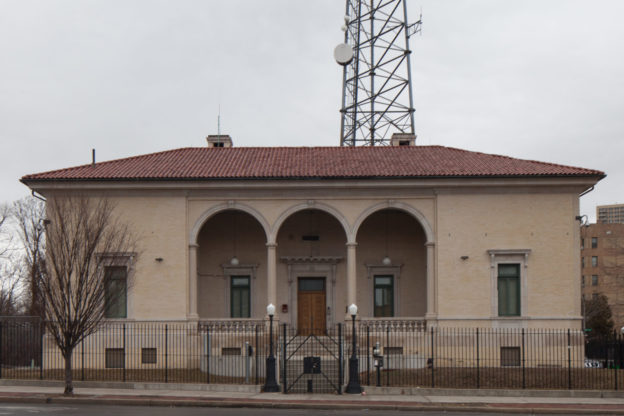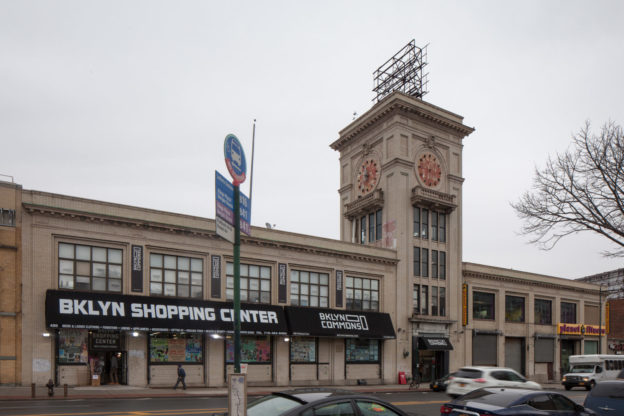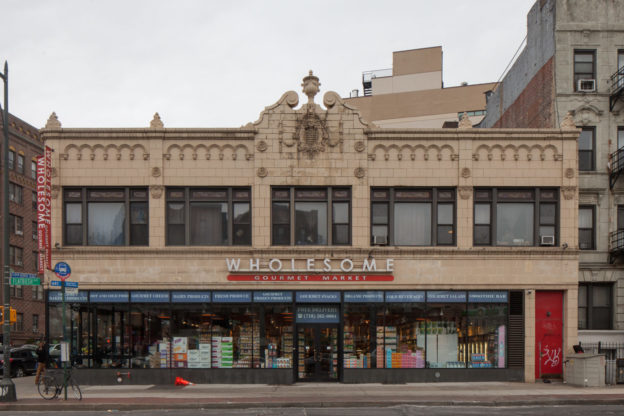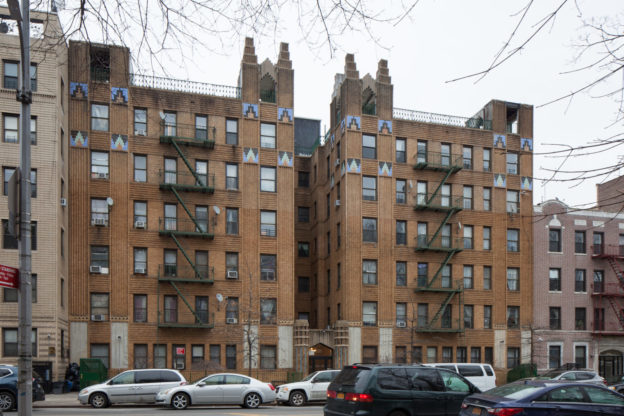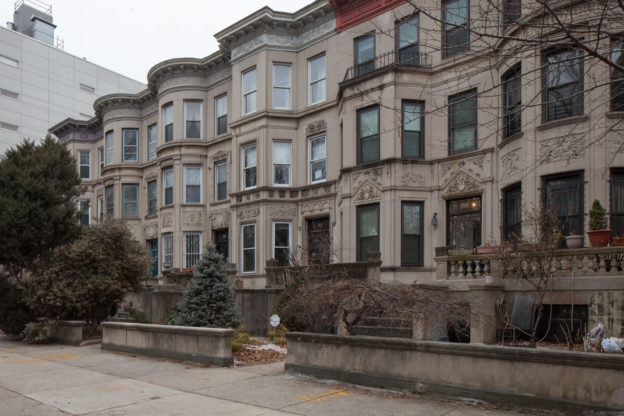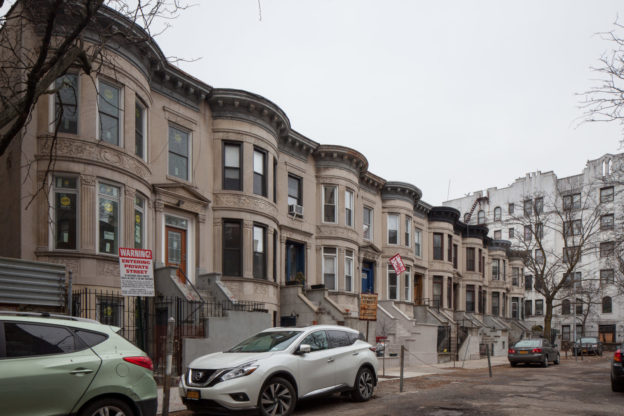Prospect Park, near Willink
Entrance at Flatbush Avenue and Empire Boulevard
1777-83
Though not technically in Prospect Lefferts Gardens, the Lefferts House is undeniably significant to the history of the neighborhood. It was built during the American Revolution, replacing the family’s earlier homestead that was burned by colonial forces. This building originally stood near Flatbush Avenue between Maple and Midwood Streets, and was designed in the Dutch manner—with a low gambrel roof and overhanging eaves—evoking the family’s long history in the area. After the death of James Lefferts (the original developer of Lefferts Manor), his family donated the old homestead to the City in 1918 with the condition that it be moved to its current site in Prospect Park. Since 1920, it has been operated as a house museum and is open to the public with exhibits on early 19th century life in Brooklyn.
35 Empire Boulevard
Frank J. Helmle
1913-16
This Renaissance Revival style T-plan building was constructed for the Fire Department of New York City and served as the central fire communications and telegraph station for the borough of Brooklyn. Four other stations were planned and built during the 1910s and ‘20s in Manhattan, The Bronx, Queens and Staten Island, addressing in part the need for an improved citywide firefighting system. A 1911 article in McClure’s magazine had called New York City’s fire-alarm system the “worst” and most antiquated in the nation. These stations were intended to improve the efficiency of municipal fire-fighting efforts by receiving all fire signals from across a borough, and then routing the signals to the appropriate local precinct. The buildings were typically located in or near parks in order to minimize the threat of fire, but also to provide space for the large radio towers transmitting the fire signals. Architecturally, the Brooklyn station is an excellent example of the City Beautiful movement. This otherwise utilitarian building is given an important civic presence through the use of high-style design, materials and ornament, in this case inspired by an early Italian Renaissance “palazzo.” With its counterparts in the other four boroughs, the Brooklyn station represents an important step taken by the FDNY in response to the growing threat of fire in the city’s tenement and industrial districts in the early years of the 20th century. The property is still owned by the FDNY, and is an Individual Landmark.
479-497 Flatbush Avenue
Attributed to Corry B. Comstock
1924-25
Flatbush Avenue, already a well-traveled street in the 19th century, became a major commercial thoroughfare in the 20th century as the neighborhoods around it were built up. Even the Lefferts family acknowledged this and apparently did not impose covenants on its lots lining the east side of the avenue. Residents and civic organizations closely watched the development and loudly protested any new building they believed was out of character. Such was the case for this bakery, which was criticized as too large and too industrial. One article quoted an aggrieved neighbor as saying that, “It seems almost criminal to permit a factory to be constructed at the entrance to one of the finest residential sections of the boro.” In spite of these concerns, the bakery was eventually built by the General Baking Company. Its design has been attributed to Comstock, who designed several bakeries in the city, including at least one other for the same company. Contemporary passersby might wonder what all the fuss was about. The two-story building fits nicely in its context (although the clock tower would have stood out at the time) and its spare, Classical details, fine brickwork and terracotta ornament are both restrained and well executed. Locals were eventually won over and fondly remember the lovely aroma wafting from this direction until the bakery closed in 1996.
Murray Klein
1930
The terra-cotta ornament on this small commercial building is nearly identical to similar structures throughout the five boroughs. Several of these were associated with Child’s restaurants (including the landmark location on the Coney Island Boardwalk), although there is no indication this was ever occupied by the chain. Instead, records indicate that the first tenant of this building was the Tiny Tim Golf Club, which occupied the entire upper floor. Miniature golf was in the midst of a wild surge in popularity at this time. According to government estimates in 1930, there were 25,000 courses in the country, 15,000 built within the previous year. Indoor courses were the latest rage, allowing year-round play even in urban areas like Brooklyn. After the Great Depression brought a quick halt to miniature golf’s popularity, later occupants of the building included the Prospect Park Jewish Center in the 1940s, which later built its own building in the neighborhood. The building’s architect, Murray Klein, designed a number of theaters and other places of amusement in Brooklyn during the 1920s and ‘30s.
Boris W. Dorfman, 1928
Morris Whinston, 1951
This six-story apartment house is a stand-out along this stretch of large apartment buildings, mostly built between the 1920s and ‘40s in the popular architectural revival styles of the day. This building presents a jazzy Art Deco façade, busy with geometrically-patterned brickwork and cast-stone and polychrometile accents. Its narrow recessed entry court is marked by beacon-like columns and its corner towers are crowned with cascading stepped pyramids and corbelled arches— forms that are evocative of Mayan architecture. As with the neighboring buildings, the large footprint and six-story height of this apartment house took shape because of the 1901 Tenement House Act, which set higher standards for light and air in residential construction by regulating lot coverage, height and exterior wall exposure. The later Multiple Dwellings Law of 1928 further increased minimum courtyard sizes. Hidden from the street by seemingly monolithic façades, these buildings all incorporate at least one interior courtyard. This building has a roughly X-shaped plan of five distinct apartment wings organized around front, rear and side light courts. A few doors to the south is the former Prospect Park Jewish Center at 153 Ocean Avenue (attributed to Morris Whinston, 1951), a notably late iteration of the related Art Moderne style. It originally housed a spacious synagogue, a Talmud Torah school, a large auditorium, a library, meeting rooms and recreational facilities.
189 to 211 Ocean Avenue
Ocean Avenue, a couple blocks west of Lefferts Manor, was mostly built up with six-story apartment buildings capitalizing on the park views and lack of restrictive covenants, but these 12 rowhouses are the exception. The ten limestone-fronted buildings (nos. 193 to 211) were designed in 1909 by Axel S. Hedman for developer Charles G. Reynolds in the popular Renaissance Revival style. These lots were especially deep, extending 150’ to the Brighton Beach rail line, and the architect took advantage by setting the houses well back from the street line and incorporating terraces and landscaped yards. Interestingly, no. 193 was once owned and occupied by Charles Ebbets, owner of the Brooklyn Dodgers and developer of Ebbets Field. The adjacent brick rowhouses were built just a few years later. Civil engineer Philip A. Faribault designed his own home at no. 191 around 1915, while Reynolds commissioned Eric O. Holmgren for the complimentary building at no. 189 in 1917-18. Originally proposed as part of the Prospect Lefferts Gardens Historic District in the 1970s, this district’s designation in 2009 was spurred on by the modern development at no. 185. Until 2008, it was the site of an elegant detached house that was part of the original development. Its sale and subsequent demolition spurred the neighbors to mount a successful campaign to win designation for the remainder of the row, and the empty site itself was briefly considered for landmark status in order for the LPC to guide its redevelopment (the LPC ultimately rejected the designation).
15 to 31 and 16 to 32 Chester Court
Peter J. Collins
1911-12
A brief walk down this short, dead-end street off busy Flatbush Avenue is like stepping into medieval England. The cohesive collection of 18 Tudor Revival rowhouses— designed and built by a prominent local architect/ developer—was inspired by 16th century “black-andwhite” buildings of Chester, England (as well as the later “Black-and-White Revival” houses of the late 19th and early 20th centuries). The Tudor Revival style, common for freestanding houses of this period, was much more unusual for attached rowhouses. Characteristic features include the stuccoed upper stories with faux half timbering meant to imitate their ancient wood-framed predecessors. Though located just outside Lefferts Manor, these houses were originally intended for singlefamily occupancy; in fact, they are nearly identical to the group of 18 houses on Rutland Road just east of Flatbush Avenue designed and built by Collins in 1914-15 following the restrictive covenants.
2 to 14 and 1 to 17 Parkside Court
Thomas J. Sinnott
1909-10
This private, dead-end street can be glimpsed from Parkside Avenue. Like Chester Court (site 11), it was a picturesque solution to the awkward interruption of the street grid by the exposed tracks of the Brighton Beach line. These two-family rowhouses were more traditional than the Parkside Avenue Duplexes, with a tall stoop leading to a single entrance providing access to both apartments. Sinnott, a local builderarchitect, claimed this was to “avoid the two long flights to reach the upper apartment, there being only one flight above the stoop.” He further stated that, “my idea in erecting these has been to provide a structure in which a man with a family can have ample room and live as much by himself as in a single family house and yet have a full suite to rent for enough to pay all the carrying charges on his investment.” Sinnott also touted the “unique” rear piazzas, claiming the houses on the west side of the street overlooked Prospect Park. The stone rubble wall at the end of the court is an original feature, supposedly “adorned with plants and vines.”
352 to 386 and 377 to 413 Parkside Avenue
Benjamin Driesler
1909
Back outside of Lefferts Manor, the blocks between Winthrop Street and Clarkson Avenue were developed in large part by the Brown family and therefore not subject to restrictive covenants. During the late 19th century, the Browns maintained a rather sizeable estate on this property, which they operated as a semi-public botanical garden with several large conservatories and a notable flower collection. Enthusiastic supporters of Flatbush’s transformation into an urban neighborhood, they began subdividing their property just after the turn of the century. In 1908, Parkside Avenue, which had existed on paper as Robinson Street, was cut through their land. Almost immediately the Browns hired Driesler to design these two rows of two-family houses. Architecturally innovative, these dwellings did not imitate single-family rowhouses, but instead proudly signaled the presence of two apartments with separate entrances, which were meant to maximize privacy between the units. This layout comprises a distinct, if short-lived, building type that has been referred to as the Brooklyn Duplex or Kinko House (after the Kings & Westchester Land Company, which was the first to build one in 1904-05). The adjacent rows of two-family houses at nos. 290 to 304 (completed 1912) and nos. 357 to 375 (1914)—also by Driesler for William Brown—are somewhat more traditional in that they forgo the double entrances, but are nonetheless stylistically inventive.
1950 Bedford Avenue
Harold S. Granger of Nelson & Van Wagenen
1916-17
The Gothic Revival style Congregational Church of the Evangel was the congregation’s first purpose-built home. Church members began worshipping together at this site in 1907, having moved south to the Prospect- Lefferts neighborhood from the Lewis Avenue Congregational Church in Bedford-Stuyvesant. By this time, Flatbush was rapidly developing from farmland into commuter suburbs, and the occupants of the tidy new rows of architectdesigned houses were building new places of worship consistent with the character of a desirable, middle-class community. The Church of the Evangel features the small scale, rustic materials palette, and irregular, picturesque massing of a medieval English parish church, which provided the formal basis of the Gothic Revival style as applied to American ecclesiastical architecture of the late 19th and early 20th centuries. Notable features include the crenellated tower, slate roofs, pointed-arch nave window and a c. 1927 Tiffany window located in the chancel (viewable from inside the church). Some of the building’s rough-faced stone is believed to have come from excavations for subway stations in Manhattan. As the Prospect-Lefferts area began to receive a significant number of Caribbean immigrants and African-American migrants by the mid-20th century, the Church of the Evangel’s membership changed in step with this demographic shift and in the 1960s was peacefully integrated. In 1977 the church’s first African-American pastor, the Reverend Charles Fisher, began leading the congregation. The Congregational Church of the Evangel is located on the listed on the State and National Register of Historic Places.


